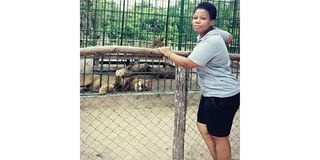Prime
Tanzanian Tour guide raises alarm over urban zoos amid Tanzania’s wild beauty

What you need to know:
- Ancilar is troubled by a phenomenon she deems incongruent with the country’s natural bounty, the proliferation of urban zoos
With more than seven years of experience under her belt, Ancilar Plucti Akonay has mastered the art of guiding tourists across Tanzania’s breathtaking landscapes.
From sprawling national parks to storied cultural heritage sites.
Through every trail and track, she has led foreign visitors to the wonders that make Tanzania an unrivalled destination.
Yet despite the sector’s commendable strides to attract more visitors, Ancilar is troubled by a phenomenon she deems incongruent with the country’s natural bounty, the proliferation of urban zoos.
“It’s hard to understand why anyone would cage wild animals in Dar es Salaam when we have hundreds of thousands roaming free in our national parks. Why not just drive a little further and see them where they truly belong?” she posed during an interview.
Ancilar’s journey in the tourism sector began modestly. After years of hard work and dedication, she established her own company, where she now serves as tour leader.
In this role, she not only curates memorable experiences for tourists but also mentors aspiring female guides navigating a profession still dominated by men — a space where women often struggle to be seen as capable.

Based in Dar es Salaam, Ancilar often introduces visitors to historical landmarks, museums, and the serene coastline.
On occasion, however, she takes them to the city’s zoos — a decision she makes with reluctance, usually at the insistence of clients seeking to see wildlife without venturing far.
“In the zoos, you can see the animals up close, take pictures with them — all for a fee,” she said, recalling a moment she herself was photographed cradling a lion cub.
“But behind that novelty is a deep discomfort. The experience lacks the authenticity of the wild, and the animals don’t belong there.”
She was informed, albeit vaguely, that some of the animals in the zoos were once injured or ill, and were brought in for treatment.
However, she was never officially told why many of them never returned to the wild.
With the experience of having watched majestic animals roam the plains freely, Ancilar finds it disheartening to see those same creatures subdued behind bars.
“The lions, once regal and dominant, appear lifeless and defeated in their cages,” she observed. “They look drained, weak — it’s heartbreaking.”
For Ancilar, zoos undermine the essence of Tanzania’s tourism.
She argues that they add little value to the industry and only cater to a small fraction of tourists who do not wish to travel beyond the city limits.
Yet, despite this limited appeal, urban zoos continue to draw interest — particularly from schools conducting field trips, and local families seeking inexpensive holiday outings.
“Of course, it's cheaper to take students to a zoo where they’re guaranteed to see animals. But at what cost?” she asked.
“The children leave with the wrong impression of wildlife — caged, tired, immobile.”
Some zoos have gone further, marketing themselves as destinations for wedding photos and social media content.
Newlyweds pose beside caged lions while others snap selfies with sedated cubs.
Ancilar sees this as a perversion of Tanzania’s natural heritage.
“In a city where leisure options often centre around bars and nightclubs, the zoo might appear to offer a different form of entertainment,” she admitted.
“But if someone visits once, they’re unlikely to return. The atmosphere is dull. The grounds are barren. The animals are visibly malnourished.”
According to her, the enclosures lack greenery, and the range of animals is unimpressive.
A handful of lions and leopards, some baboons and monkeys — all confined, many appearing listless.
The monkeys, she noted, seemed resigned to their unnatural surroundings, their eyes betraying a desire to swing freely through the treetops.
“The herbivores suffer terribly in the dry season — the grass is sparse and dry. And the carnivores? The lions barely eat twice a week,” she remarked.
These insights are not speculative; they come from direct experience.
Once, she accompanied a group of tourists from Malaysia who wished to explore Dar es Salaam without venturing upcountry.
She took them to the National Museum and House of Culture, where they were delighted to learn about Tanzanian history and traditions.
But when they requested to see wildlife, she took them — reluctantly — to a zoo.
“At first, they were thrilled to see the animals up close,” she recalled. “But that soon turned to sadness. They could see the lions pacing restlessly, clearly desperate to escape. The thrill faded quickly. They felt like accomplices in the animals’ captivity.”
She added that students often encounter animals lying idle, asleep or unresponsive.
Only when agitated do they stir — not a conducive environment for fostering love for nature.
“What sort of education is that?” she asked.
“We’re supposed to be inspiring future conservationists, not desensitising children to animal suffering.”

She also raises ethical concerns about the treatment of cubs. In some facilities, lion cubs are separated from their mothers for the sole purpose of human interaction.
Visitors are charged for every photograph taken with them.
While these images may trend online, Ancilar says the practice does lasting harm to the animals.
“It may look cute on Instagram, but those cubs are being raised to accept humans instead of learning to survive in the wild,” she said.
“It’s a trade-off of their natural instincts for profit.”
Her disillusionment is stark when she compares today’s urban zoo scenes with her formative experiences.
As a young woman fresh from school, she was posted to Lake Manyara National Park for fieldwork by the Tanzania National Parks Authority (Tanapa).
There, the untamed beauty of the wilderness left a profound mark on her.
She began her professional journey in 2014, working in an entry-level position that involved welcoming tourists at the airport.
Over the years, she built a strong network, earning trust through consistency and professionalism.
Her reputation enabled her to establish her company, Tanzy Asilia Adventure, which she now runs independently.
The transition from employee to entrepreneur was far from easy.
But with persistence and glowing recommendations from past clients, she managed to attract new business and keep her venture afloat.
Today, when tourists request city tours, she steers them towards more enriching experiences.
“Dar es Salaam has so much more to offer,” she said.
“From the bustling Kariakoo market to the historical Azania Front and the vibrant Makumbusho village — you can experience the soul of Tanzania without ever seeing a caged animal.”
She believes tour operators have a duty to guide tourists ethically and responsibly.
“It’s not just about the money. We must respect the creatures that make this land so special,” she said.
Her hope is that the tourism industry in Tanzania will shift away from supporting facilities that confine wildlife in the name of entertainment.
Instead, she envisions a future where conservation and authentic experiences take centre stage.
“We’re blessed with some of the world’s most incredible ecosystems,” she concluded.
“Let’s not forget that. Let the animals roam where they were meant to. And let us show the world Tanzania in its true, untamed glory.”



